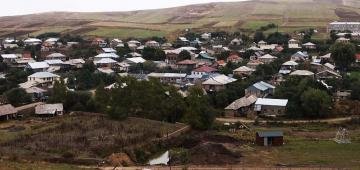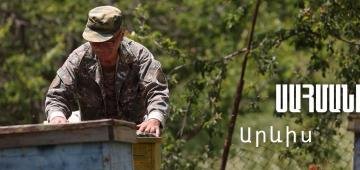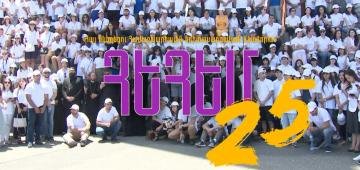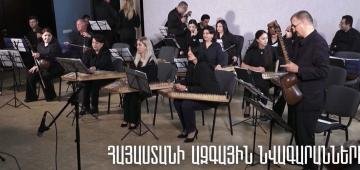 |
"Artsakh" Chamber OrchestraAfter the Armenian exodus from Artsakh in 2003, the Artsakh Chamber Orchestra, like many orchestras and ensembles, found itself in an uncertain state, with its musicians left unemployed. With the help of world-renowned musicians Hasmik Papyan and Narek Hakhnazaryan and with the financial support of the AGBU, the orchestra was reorganized in Yerevan. A new page has begun in the orchestra's life, the key goal of which is to make the name of Artsakh heard on prestigious stages around the world. |
 |
Spyridon MelikyanComposer Spyridon Melikyan left behind symphonic and choral works. As a conductor, he raised Armenian choral art to a new level. As an ethnographer, he saved a great treasury of folk songs from oblivion. As a scholar, he examined the theoretical issues of Armenian music in a new light. The former seminarian’s entire life was a service to Armenian music and Armenology. |
 |
VahanThe border village of Vahan is the northeastern gateway to Armenia. The village borders Azerbaijan for about 27 km. In some parts, the border is only 2-3 km away. The century-old village has had other names in the past. It was founded in 1925 under the name Rubenakert, renamed Ordzhonikidze during the Soviet era, and in 1991 received its current name in honor of the brave eagle of Artsvashen, Father Vahan. |
 |
Ulikhanyan sistersVictoria and Liana Ulikhanyan have been engaged in classical music since childhood. They have already managed to perform on international platforms, participate in festivals, competitions, and have concerts on international stages. In addition to performing arts, the violinist and cellist sisters also create, and a video clip of Victoria Ulikhanyan's piano trio composition "Mechanics of the Sun" was recently shot, with which the girls are trying to popularize classical music. |
 |
Sebastian Teachers' ChoirThe "Sebastatians" teacher's choir has been operating since 2012. The founder of the Yerevan State Chamber Choir, Honored Artist Harutyun Topikyan, was the conductor at the foundation of its formation. It is a four-part, open choir, composed of educators from the educational complex. The choir performs Komitas' spiritual and secular songs, medieval hymns, works by modern Armenian composers, and disseminates them through educational, cultural, and patriotic campaigns-concerts, educational liturgies, and organizing and participating in national rituals-festivals. |
 |
Aghitu Monument and Tanahat MonasteryThe Tanahat Monastery, or as the locals call it, the Red Monastery, is located 25 km southwest of Sisian, near the village of Arevis. Stepanos Orbelyan called the monastery a “great monastery of virtues,” where numerous legends about the holy life of ascetics and lay clergy were woven. During our trip, we also presented the unique monument of the 6th-7th centuries in the village of Aghitu. |
 |
Arevis
The village of Arevis is located about 20 km from Sisian, but due to the poor road, it takes hours to reach the village.
Officially, Arevis has 41 residents, who live in the village intermittently, coming in the spring for agriculture and beekeeping. In the winter, barely ten residents remain in Arevis. Arevis is 4 km away from the enemy, but the reason the village has no residents is not at all its proximity to the border, but the lack of living conditions.
|
 |
"Kadance" ensembleThe "Kadance" ensemble, which has a history of more than 20 years, has been reorganized, and a dance group has been added to the famous musical quintet. If in the beginning "Kadance" performed mainly the works of Astor Piazzolla, then over time the ensemble has expanded its performances to include works by European, American, Russian and Armenian classical and contemporary composers. From now on, "Kadance" will perform in a new way and in a new format. |
 |
Sisian: St. Gregory the Illuminator ChurchAfter the destruction of the Syunik principality of Shaghat and the monastery by Persian troops in the 360s, the Syunik monastery became the main sanctuary of the Syunik principality and until the 9th century was the episcopal seat of Syunik and the center of the ministerial dynasty. In the 80s of the 6th century, the Syunik princess Varazdukht built the St. Gregory the Illuminator temple on the site of the ancient temple of the monastery, which is now the visiting card of Sisian. |
 |
ACYO 25The World Armenian Church Youth Organization celebrates its 25th anniversary this year. It all began in 2001, when Armenia celebrated the 1700th anniversary of the proclamation of Christianity as the state religion. Under the direction of His Holiness Karekin II, Catholicos of All Armenians, a youth office was established, the goal of which was to activate the involvement of youth in the life of the Armenian Church. It was on the basis of this structure that the World Armenian Church Youth Organization- the ACYO, was established years later. |
 |
State Orchestra of National Instruments of ArmeniaThe State Orchestra of National Instruments of Armenia was established in 2005 on the initiative of Ara Gevorgyan and conductor Norayr Davtyan. It has undertaken a mission to preserve and develop the folk orchestral performing art formed in Armenia. From film music to adaptations of classical works, the orchestra presents national instruments in a new way. |
 |
OghbiOne of the 60 abandoned villages in Vayots Dzor is Oghbin. It is not known what the name of the settlement means or how it is explained. The village borders Azerbaijan, located about 8 km northeast of the village of Khndzorut. The only remaining witness to the abandoned village is the Oghbin church, built in 1666 and carved into the rocks.
|
